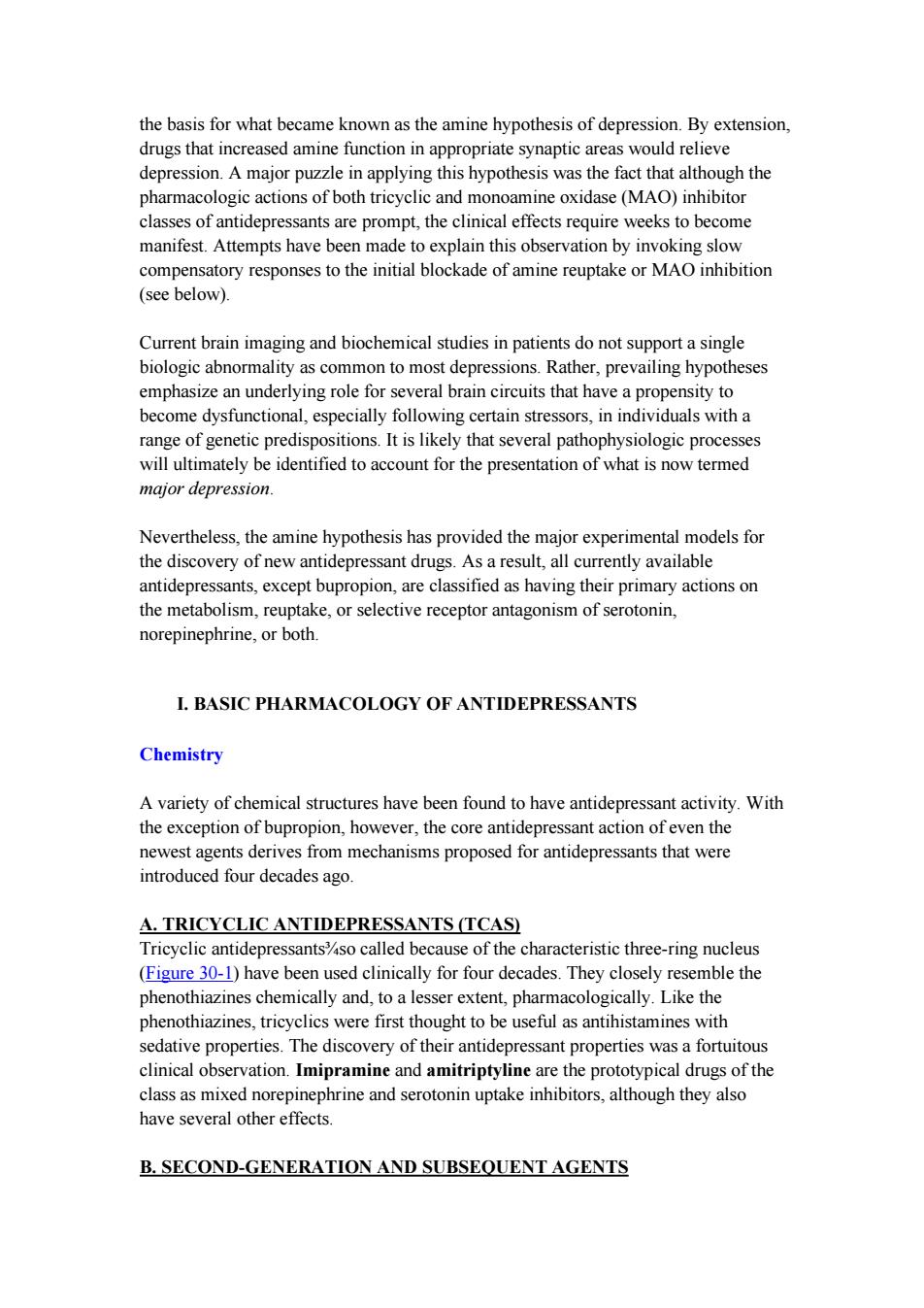正在加载图片...

the basis for what became known as the amine hypothesis of depression.By extension, drugs that increased amine function in appropriate synaptic areas would relieve depression.A major puzzle in applying this hypothesis was the fact that although the pharmacologic actions of both tricyclic and monoamine oxidase(MAO)inhibitor classes of antidepressants are prompt,the clinical effects require weeks to become manifest.Attempts have been made to explain this observation by invoking slow compensatory responses to the initial blockade of amine reuptake or MAO inhibition (see below). Current brain imaging and biochemical studies in patients do not support a single biologic abnormality as common to most depressions.Rather,prevailing hypotheses emphasize an underlying role for several brain circuits that have a propensity to become dysfunctional,especially following certain stressors,in individuals with a range of genetic predispositions.It is likely that several pathophysiologic processes will ultimately be identified to account for the presentation of what is now termed major depression. Nevertheless,the amine hypothesis has provided the major experimental models for the discovery of new antidepressant drugs.As a result,all currently available antidepressants,except bupropion,are classified as having their primary actions on the metabolism,reuptake,or selective receptor antagonism of serotonin, norepinephrine,or both. I.BASIC PHARMACOLOGY OF ANTIDEPRESSANTS Chemistry A variety of chemical structures have been found to have antidepressant activity.With the exception of bupropion,however,the core antidepressant action of even the newest agents derives from mechanisms proposed for antidepressants that were introduced four decades ago. A.TRICYCLIC ANTIDEPRESSANTS (TCAS) Tricyclic antidepressants%so called because of the characteristic three-ring nucleus (Figure 30-1)have been used clinically for four decades.They closely resemble the phenothiazines chemically and,to a lesser extent,pharmacologically.Like the phenothiazines,tricyclics were first thought to be useful as antihistamines with sedative properties.The discovery of their antidepressant properties was a fortuitous clinical observation.Imipramine and amitriptyline are the prototypical drugs of the class as mixed norepinephrine and serotonin uptake inhibitors,although they also have several other effects. B.SECOND-GENERATION AND SUBSEQUENT AGENTSthe basis for what became known as the amine hypothesis of depression. By extension, drugs that increased amine function in appropriate synaptic areas would relieve depression. A major puzzle in applying this hypothesis was the fact that although the pharmacologic actions of both tricyclic and monoamine oxidase (MAO) inhibitor classes of antidepressants are prompt, the clinical effects require weeks to become manifest. Attempts have been made to explain this observation by invoking slow compensatory responses to the initial blockade of amine reuptake or MAO inhibition (see below). Current brain imaging and biochemical studies in patients do not support a single biologic abnormality as common to most depressions. Rather, prevailing hypotheses emphasize an underlying role for several brain circuits that have a propensity to become dysfunctional, especially following certain stressors, in individuals with a range of genetic predispositions. It is likely that several pathophysiologic processes will ultimately be identified to account for the presentation of what is now termed major depression. Nevertheless, the amine hypothesis has provided the major experimental models for the discovery of new antidepressant drugs. As a result, all currently available antidepressants, except bupropion, are classified as having their primary actions on the metabolism, reuptake, or selective receptor antagonism of serotonin, norepinephrine, or both. I. BASIC PHARMACOLOGY OF ANTIDEPRESSANTS Chemistry A variety of chemical structures have been found to have antidepressant activity. With the exception of bupropion, however, the core antidepressant action of even the newest agents derives from mechanisms proposed for antidepressants that were introduced four decades ago. A. TRICYCLIC ANTIDEPRESSANTS (TCAS) Tricyclic antidepressants¾so called because of the characteristic three-ring nucleus (Figure 30-1) have been used clinically for four decades. They closely resemble the phenothiazines chemically and, to a lesser extent, pharmacologically. Like the phenothiazines, tricyclics were first thought to be useful as antihistamines with sedative properties. The discovery of their antidepressant properties was a fortuitous clinical observation. Imipramine and amitriptyline are the prototypical drugs of the class as mixed norepinephrine and serotonin uptake inhibitors, although they also have several other effects. B. SECOND-GENERATION AND SUBSEQUENT AGENTS